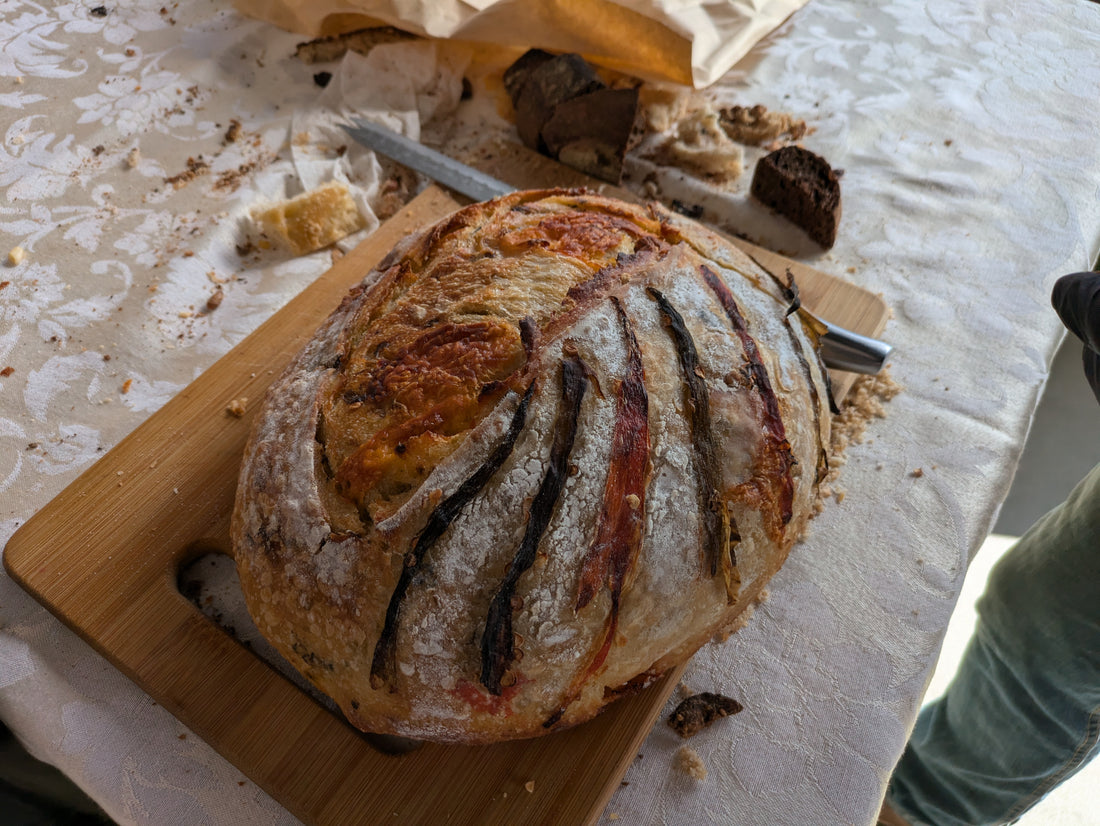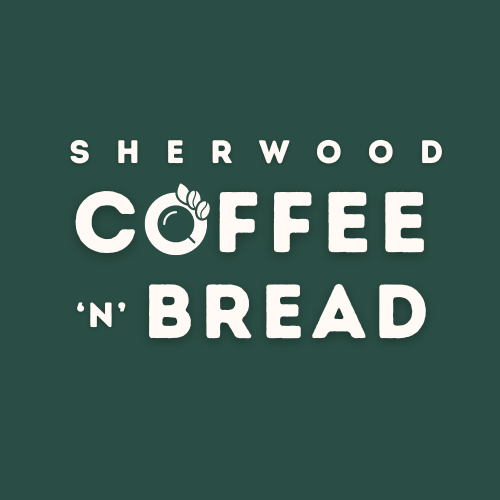
Bread Baking Terms Explained: A Guide for Bakers
Share
Baking bread is an art and science, and like any craft, it comes with its own set of terms and techniques. If you’ve ever come across phrases like cold fermentation, hydration, or stretch-and-fold and felt lost, you’re not alone. This guide is here to demystify these essential bread baking terms and help you bake better bread, whether you're a beginner or a seasoned baker.
At Sherwood Coffee 'n' Bread, where we teach hands-on bread baking classes in Albuquerque, we’ve seen how understanding these terms can elevate your baking. So, bookmark this guide and get ready to knead, proof, and bake with confidence!
Fermentation and Proofing Terms
Cold Fermentation (Retarding)

- What It Is: A slow fermentation process where dough is placed in the refrigerator to develop flavor over an extended period.
- Why It Matters: Enhances taste, improves texture, and allows flexibility in baking schedules.
- Tip: Try a cold ferment for 12-24 hours for deeper, more complex flavors. Perfect for sourdough and artisan breads.
Bulk Fermentation

- What It Is: The initial rise after mixing, where the dough ferments as one large mass.
- Why It Matters: Builds gluten structure and develops flavor.
- Tip: Perform stretch-and-folds during bulk fermentation to strengthen the dough without over-kneading.
Final Proof

- What It Is: The last rise after shaping and before baking.
- Why It Matters: Determines the bread’s final texture and volume.
- Tip: Dough should feel puffy but still spring back slightly when gently pressed.
Overproofing
- What It Is: When dough ferments too long, causing it to collapse and lose structure.
- Why It Matters: Leads to dense, flat bread.
- Tip: In high-altitude areas (like Albuquerque, at 5,000 feet), reduce proofing times by 25-30% to avoid overproofing.
Yeast Activity

- What It Is: The process where yeast consumes sugars and produces carbon dioxide gas, making the dough rise.
- Why It Matters: Proper yeast activity leads to a well-risen loaf with good texture.
- Tip: Control yeast activity by adjusting dough temperature and proofing times.
Pre-Ferments and Starters
Poolish
- What It Is: A highly hydrated (usually 100%) pre-ferment made with equal parts flour and water, plus a small amount of yeast.
- Why It Matters: Poolish enhances flavor, aroma, and dough extensibility, commonly used in baguettes and other artisan breads.
- Tip: Prepare the poolish 8-12 hours before baking and use when it’s bubbly and slightly domed.
Biga
- What It Is: A low-hydration (usually 50-60%) Italian pre-ferment, made with flour, water, and a small amount of yeast.
- Why It Matters: Biga adds structure and a mild, nutty flavor, ideal for ciabatta and rustic Italian breads.
- Tip: Allow the biga to ferment for 12-16 hours at room temperature before incorporating it into the final dough.
Sourdough Starter (Levain)
- What It Is: A mixture of flour and water that captures wild yeast and bacteria, used as a natural leavening agent.
- Why It Matters: Provides complex flavors and improved digestibility, essential for sourdough bread.
- Tip: Feed your starter regularly to keep it active. Use it when it’s doubled in size and bubbly for the best results.
Sponge
- What It Is: A pre-ferment that’s a bit wetter than a biga but less hydrated than a poolish (typically 60-70%).
- Why It Matters: Common in sandwich loaves and enriched breads, a sponge boosts flavor and dough strength.
- Tip: Let the sponge rise for 4-6 hours or until it’s puffy and full of bubbles.
Pâte Fermentée (Old Dough)
- What It Is: A piece of fermented dough from a previous batch that’s added to new dough.
- Why It Matters: Adds depth of flavor and improves dough strength.
- Tip: Use pâte fermentée within 48 hours for the best results. Store it in the fridge until you’re ready to bake.
Mixing and Kneading Terms
Kneading
- What It Is: Working the dough to develop gluten strands.
- Why It Matters: Gluten gives the dough structure, allowing it to rise properly.
- Tip: Knead until the dough is smooth and elastic, or use the stretch-and-fold method to avoid overworking the dough.
Stretch-and-Fold Technique
- What It Is: A gentle method of kneading by stretching and folding the dough.
- Why It Matters: Develops gluten without excessive kneading, preserving the dough’s hydration.
- Tip: Perform 3-4 sets during bulk fermentation, spaced 20-30 minutes apart.
Autolyse
- What It Is: A resting period after mixing flour and water, before adding yeast and salt.
- Why It Matters: Allows flour to fully hydrate and gluten to begin developing naturally.
- Tip: Autolyse for 20-60 minutes to improve dough texture and reduce kneading time.
Gluten Development
- What It Is: The formation of a network of gluten strands that trap gas produced by yeast.
- Why It Matters: Essential for creating a chewy, well-structured bread.
- Tip: Use the windowpane test: stretch a small piece of dough until it’s thin and translucent without tearing.
Dough Characteristics
Hydration
- What It Is: The ratio of water to flour in the dough, expressed as a percentage.
- Why It Matters: Affects dough texture, ease of handling, and the bread’s crumb.
- Tip: Higher hydration (70-80%) yields open, airy bread; lower hydration (60-65%) produces denser loaves.
- Tools: Try our Dough Hydration Calculator
Dough Temperature
- What It Is: The temperature of your dough during mixing and fermentation.
- Why It Matters: Influences yeast activity and fermentation speed.
- Tip: Aim for a dough temperature around 78°F (25°C). In winter, use slightly warmer water; in summer, add ice to keep dough cool.
Crumb Structure
- What It Is: The pattern of holes and texture inside the bread.
- Why It Matters: Indicates the quality of fermentation and gluten development.
- Tip: Higher hydration and proper proofing lead to a more open crumb.
Tacky vs. Sticky Dough
-
What It Is:
- Tacky Dough: Slightly sticky but manageable.
- Sticky Dough: Clings excessively to hands and surfaces.
- Why It Matters: Helps adjust hydration levels and understand dough handling.
- Tip: For high-hydration doughs, work with wet hands to reduce sticking.
Baking Terms
Scoring

- What It Is: Making deliberate cuts on the dough’s surface before baking.
- Why It Matters: Directs the bread’s expansion during baking.
- Tip: Use a razor blade or sharp knife for clean, controlled cuts.
Crust Formation
- What It Is: The outer layer that forms during baking.
- Why It Matters: Adds flavor, texture, and visual appeal.
- Tip: Introduce steam in the first 10-15 minutes of baking for a crisp, golden crust.
Oven Spring
- What It Is: The rapid rise of dough when it first enters the hot oven.
- Why It Matters: Creates a light, airy loaf.
- Tip: Preheat your oven thoroughly and bake with steam to maximize oven spring.
Maillard Reaction
- What It Is: The chemical reaction that browns the crust and develops rich flavors.
- Why It Matters: Gives bread its signature taste and appearance.
- Tip: Bake until the crust is deep golden-brown to achieve the best flavor.
Conclusion
Mastering these bread baking terms will give you the confidence to tackle any recipe and troubleshoot challenges along the way. Whether you’re experimenting with hydration, practicing your stretch-and-fold, or fine-tuning your proofing times, this guide is your essential companion.
Want to take your bread baking to the next level? Join our Bread Baking Classes at Sherwood Coffee 'n' Bread in Albuquerque! Our hands-on classes provide personalized instruction, helping you bake better bread at any altitude. 🥖✨
